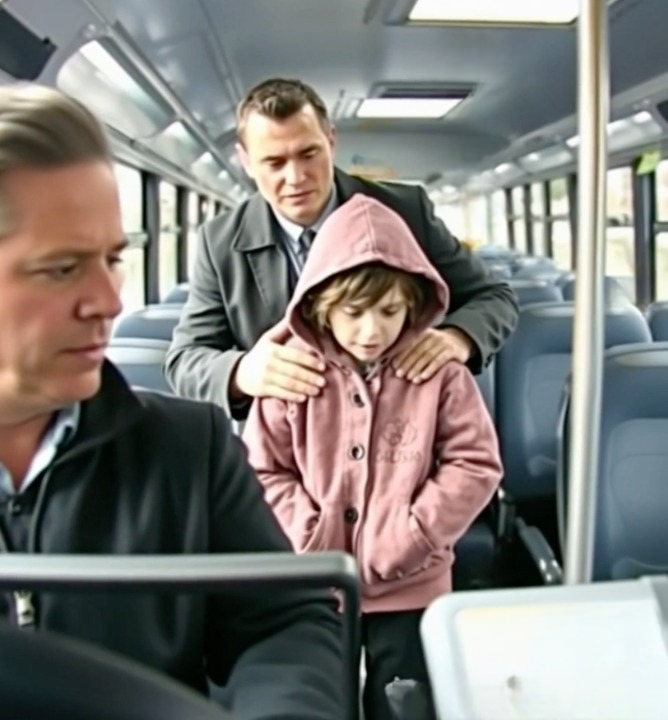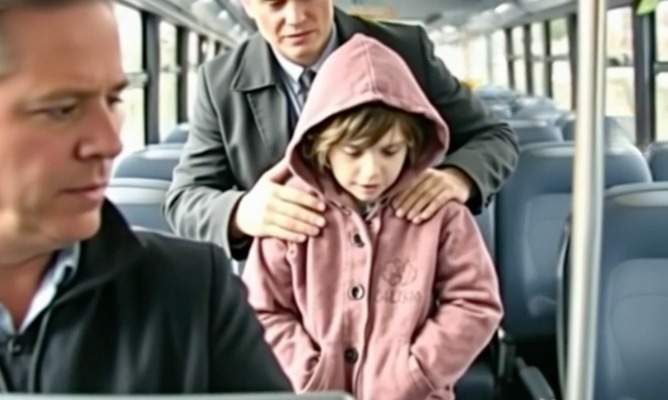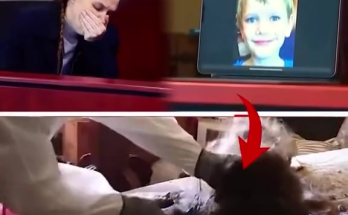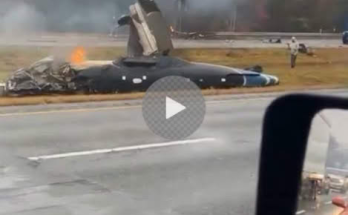
Tim’s heart raced as the small, fragile voice echoed in his mind: “Please help me.” He caught glimpses of the girl in the rearview mirror, her slight frame hunched beneath the dark hood of her jacket, her pale face barely visible against the shadowed fabric. Beside her, a man sat rigidly, eyes darting across the bus as if measuring threats from every direction.
A surge of instinct told Tim he had to act immediately. Years behind the wheel had taught him discipline, composure, and the delicate balance between alertness and calm. Panic could endanger not only the girl but every passenger on board. Taking a deep breath, Tim tightened his grip on the steering wheel, guiding the bus smoothly back into traffic while formulating a plan in his mind.
The bus moved like a giant, steel leviathan through the city streets. Inside, the hum of conversation, the shuffle of newspapers, and the faint whisper of music from headphones created a protective layer of normalcy. Tim intended to use that everyday monotony as a shield, buying precious minutes to protect the child and summon help.
Calculating the Right Moment
Tim stole a glance at his watch. Every second mattered. The next bus stop loomed in only a few minutes, and he knew he needed to alert authorities without tipping off the man whose presence radiated danger. His mind raced, analyzing possible distractions, potential allies among the passengers, and subtle ways to keep the girl calm while staying in control.
As the bus approached a red light, an idea crystallized. Tim cleared his throat and activated the intercom. “Ladies and gentlemen,” he announced, steady and measured, “we’re experiencing minor technical difficulties. We may need to pause at the next stop for a quick inspection. I apologize for the inconvenience.”
Groans and murmurs filled the cabin, but it was exactly what he needed. The passengers’ attention shifted just enough to allow Tim the cover to maneuver carefully. The bus slowed, doors swung open, and emergency lights bathed the platform in orange, signaling a pause in the ordinary routine of the day.
Engaging the Passengers
Tim rose from his seat and moved deliberately down the aisle, offering casual greetings to the passengers. His eyes never left the girl and the man, who were now locked in a silent but intense standoff of awareness. With each step, Tim projected calm authority, giving no hint of the urgency thrumming through him.
When he reached the back of the bus, he addressed the man in a tone that was polite, measured, yet unyielding. “Sir, ma’am, it looks like there’s a small issue with the ticket system. May I check your tickets, please?”
The man shifted, a flicker of irritation passing across his features, and he tightened his hold on the girl. “We paid,” he muttered, his voice low and guarded.
Tim nodded, his expression neutral. “Of course, I understand. It’s just a procedure. I’ll need to verify with the control room.” He moved as if adjusting the bus controls but discretely reached for his phone, sliding the device from his pocket and dialing 911 with a practiced hand. His voice was low, calm, explaining the situation in the guise of a technical issue while conveying enough information for law enforcement to locate the bus quickly.
The bus’s engine masked his words, allowing him to communicate silently with the authorities. The girl’s eyes followed him, glimmering with cautious hope, her whispered plea still lingering in the back of his mind.
Waiting for Reinforcements
Minutes felt like hours. Tim’s gaze shifted to the passengers, hoping for subtle signals of understanding. One observant commuter gave a slight nod, confirming they had grasped the situation and would follow instructions quietly. Tim focused on keeping both the girl and the man calm, projecting an air of routine as the bus idled at the stop.
From the driver’s seat, he kept his ears attuned to the sound of approaching sirens. Every footstep outside, every distant wail of a vehicle, heightened both his anticipation and his responsibility. He repeated reassuring glances to the girl, silently conveying: Hold on. Help is coming.
Intervention Arrives
Then, a moment of relief. Through the bus windows, Tim spotted the approaching uniforms. Officers had arrived, moving calmly but purposefully toward the bus. The man’s tense facade faltered as the reality of intervention set in. He was outnumbered, outmaneuvered, and powerless against the coordinated efforts of trained professionals.
The officers boarded, moving efficiently to ensure the child’s safety. Tim observed as the girl was gently guided away from the man, her body relaxing for the first time in what felt like an eternity. Her whispered plea had been heard, and the quiet courage of vigilance had saved her.
The Aftermath
With the immediate danger resolved, Tim allowed himself a brief moment to breathe. The bus pulled away from the stop, resuming its route, while life within the city continued seemingly uninterrupted. Yet for Tim and the girl, the morning had been anything but ordinary.
The experience left a lasting imprint. For Tim, it reinforced the profound responsibility of being alert, aware, and prepared to act. For the girl, it became a defining memory of trust, courage, and the unexpected heroism of a stranger who chose action over hesitation.
Lessons in Vigilance and Preparedness
This incident illustrates the critical role of awareness in public spaces. Everyday heroes are often ordinary people who notice subtle signs—a glance, a gesture, a whispered plea—and respond with thoughtfulness, calm, and courage.
Key lessons include:
- Trust Your Instincts – Tim’s decision to act was informed by experience, but also by an innate sense that something was wrong. Paying attention to subtle cues can prevent harm.
- Maintain Composure – Panic can escalate a situation. Projecting calm allows for better decision-making and can reassure vulnerable individuals.
- Utilize Available Resources – Communication tools, such as mobile devices, intercoms, or public alert systems, are critical for coordinating timely intervention.
- Community Support – Passengers who understood the signs and provided subtle assistance demonstrated how community awareness can amplify safety.
Broader Implications for Public Safety
While this was an isolated event, it reflects a broader need for safety protocols in public transportation. Training drivers in crisis management, recognizing signs of distress, and responding to potential threats are all essential components of risk mitigation.
Public awareness campaigns, community involvement, and coordinated law enforcement readiness also contribute to creating safer environments for everyone. Ordinary citizens, when attentive and prepared, can serve as the first line of protection in moments that demand immediate action.
Human Resilience and Courage
Beyond the procedural and safety lessons, this story is a testament to human courage and resilience. Tim’s calm decisiveness and the girl’s quiet bravery intersected in a moment that could have had a tragic ending. Instead, vigilance, empathy, and timely intervention transformed fear into safety, demonstrating the power of human action under pressure.
For the girl, the experience may have been terrifying, but it also became a lesson in trust, hope, and the kindness of strangers. For Tim, it reinforced a lifetime commitment to vigilance and care, proving that small acts—attentive observation, discreet communication, and steady composure—can change lives in profound ways.
Reflection
The story of Tim and the little girl is more than a dramatic episode—it is a reminder of how ordinary people can make extraordinary differences. In cities bustling with activity, subtle signals can go unnoticed. Yet, for those willing to notice, to act thoughtfully and courageously, the impact can be life-saving.
As public awareness grows, such narratives inspire the adoption of safety-minded behavior, the strengthening of community support networks, and the continued evolution of public transportation safety protocols.
Ultimately, this story is about hope, vigilance, and the human capacity to act decisively in the face of uncertainty. It illustrates that courage need not be loud or flashy—sometimes, it is quiet, observant, and deliberate, and it can save lives.



